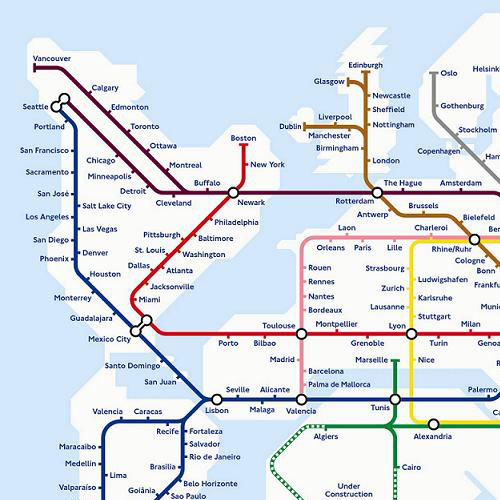It was my first semester away at college in a small Connecticut town. A group of other freshmen were talking about going down the hill into town and I heard the word “subway” in the conversation. “There’s a subway in this town?” I asked incredulous and at the same time hopeful – I had no car (or drivers license for that matter) and the prospect of public transportation was exciting and home-sick-making all at the same time. Of course, they were talking about Subway, the chain sandwich shop. Still, the fantasy of widely interconnected subway systems set up camp in my head to stay.
Some years later I was joking around with N and we developed the idea that all subway stations with the same name are connected. For example, if you took the Boston MBTA Orange line to Forest Hills (Jamaica Plain), you could go through some kind of wormhole there and transfer to the F train on New York City’s MTA at Forest Hills (Queens). The fact that the F train is orange on the MTA map just adds credence to this goofy concept, plus the bonus synchronicity that there’s a Jamaica stop at the end of the F train. More exciting still, there’s the possibilty of an interchange between my current home stop, Central on the MBTA Red line with Central on the Tsuen Wan line of Hong Kong’s MTR, which is also colored… red.
Imagine my carto-geeky joy at finding this fantasy global subway map on the Strange Maps blog.
It’s clearly based on the London map with little regard for the realities of politics or geography or the relative importance of the stations – for example, Newark and Rotterdam are interchange points but New York and Amsterdam are not (and how cool would it be to take a train from Amsterdam to New Amsterdam?) – but it’s an awesome work nonetheless, and it provides a checklist of major metro systems to visit and ride
I also like that the line connecting New York and Boston is red, the color of the MTA 1-2-3 trains and MBTA Red line which run past my childhood home in New York City and my current home in Cambridge – and which also connect those homes with the cities’ respective train stations, Penn and South stations, which define the endpoints of the Amtrak and Acela route from New York to Boston. Wow.
Check out the book, Transit Maps of the World, by Mark Ovenden, for which this fantasy map was a promotion. It’s too bad they didn’t use this promo as the actual cover of the book.


Rochester used to have a subway, read about it here: http://en.wikipedia.org/wiki/Rochester_Subway
Do any of those stops ring a bell?
The funny thing is that we came up with this idea, as I recall, while passing the Forest Hills muni stop in SF.